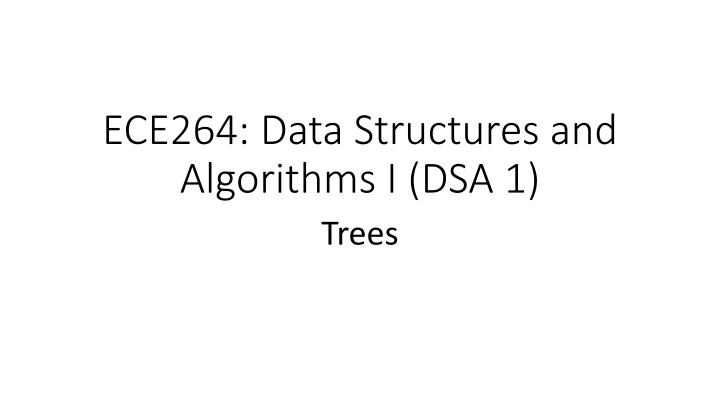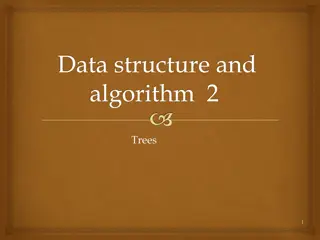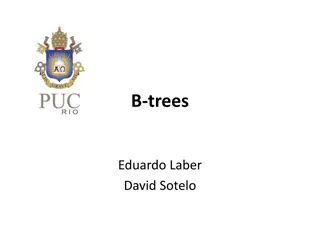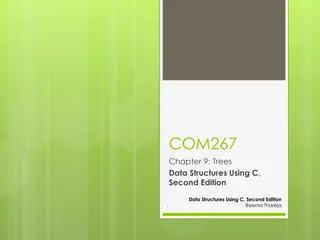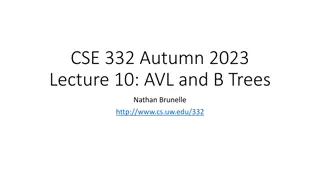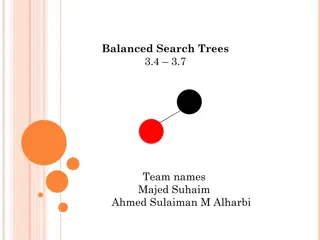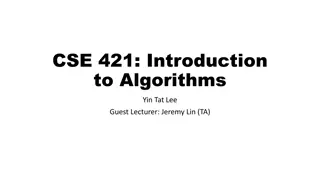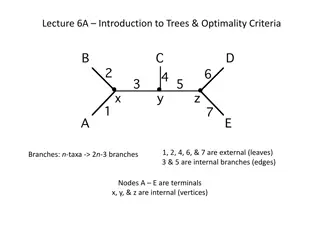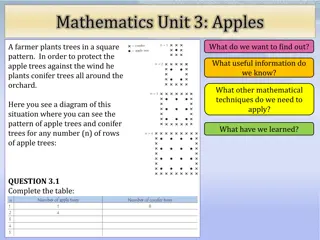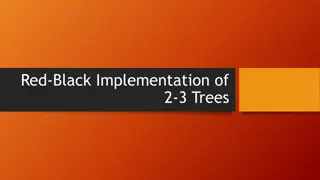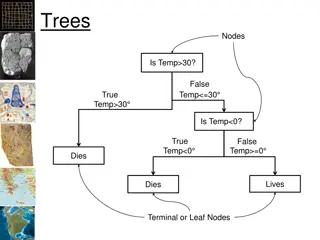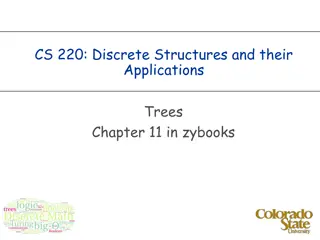Data Structures: Trees Explained
Trees in data structures are like linked lists but with a root and multiple nonempty subtrees. Nodes have parents, children, and siblings, forming paths and hierarchies. Learn about paths, depths, heights, ancestors, descendants, and implementing general trees as data structures in this comprehensive guide.
Download Presentation

Please find below an Image/Link to download the presentation.
The content on the website is provided AS IS for your information and personal use only. It may not be sold, licensed, or shared on other websites without obtaining consent from the author.If you encounter any issues during the download, it is possible that the publisher has removed the file from their server.
You are allowed to download the files provided on this website for personal or commercial use, subject to the condition that they are used lawfully. All files are the property of their respective owners.
The content on the website is provided AS IS for your information and personal use only. It may not be sold, licensed, or shared on other websites without obtaining consent from the author.
E N D
Presentation Transcript
ECE264: Data Structures and Algorithms I (DSA 1) Trees
Trees This topic is related to Chapter 4 of the textbook Like a linked list, a tree is a collection of nodes The collection can be empty; otherwise, a tree consists of a root (r) and zero or more nonempty subtrees (T1, T2, ..., Tk) Each subtree has its own root connected by a directed edge from r Every directed edge in a tree connects a parent node to a child node Every node has exactly one parent, except the root which has none Nodes that share a parent are siblings Nodes with no children are known as leaves (a.k.a. terminal nodes or external nodes) Nodes with one or more children are called internal nodes (a.k.a. non-terminal nodes) The figures on the next two slides demonstrate two ways to think about trees
Paths in Trees A path from one node to another is defined as a sequence of nodes connected by directed edges; the length of the path is the number of edges There is always exactly one path from the root to each other node in the tree; there will be no undirected cycles The depth of a node is the length of the unique path from the root to the node The depth of a tree is the depth of the deepest leaf; the root is at depth 0 The height of a node is the length of the longest path from the node to a leaf; all leaves are at height 0 If there is a path from n1to n2then n1is an ancestor of n2and n2is a descendant of n1 If n1 n2than we can use the terms proper ancestor and proper descendant A collection of trees is sometimes referred to as a forest
Implementing General Trees So far, we have discussed trees as an abstract data type (ADT) When we implement a tree as a data structure, each node will also be represented as a data structure, perhaps using a class in C++ One element of each node will be the value stored in the node; this might be some specific type, or kept general if templates are used There will also be a pointer to at least one child A node in a general tree might store a linked list of pointers to children, but this is not the usual way to implement a general tree By general tree, we mean that each node is allowed to have any number of children A common choice is to have each node store a pointer to its left child and its right sibling (so that each node has a fixed size) The figure on the next slide depicts this method of storing a general tree A node in a general tree might also store a pointer to its parent
Ordering Children The implementation involving left child pointers and right sibling pointers seems to insinuate that children of a node are ordered in some linear fashion; e.g., from left to right This is not necessarily intuitive for all trees; in general, a tree is a hierarchical data structure For example, a tree can be used to represent a file system with directories and files; children might be ordered according to ASCII, file type, date, etc., or the order of siblings may not matter A document such as a book could be represented by a tree; the root represents "book", whose children represent "parts" or "chapters", then "sections", etc.; here, the order of siblings matters Trees can also be used to represent parsed sentences broken into phrases, sub-phrases, etc., down to individual words; here again, the order of siblings matters For this last example, if the rules of the grammar are worked into the tree, then this is an example of a parse tree, a.k.a. an abstract syntax tree Computer programs can also be represented as parse trees, and some compilers might choose to do so; again, the order of siblings matters
Tree Traversal Strategies There are three important traversal strategies for trees: A preorder traversal visits the current node first (e.g., the root) and then the subtrees from left to right (using preorder traversal) An inorder traversal visits the left subtree first (using inorder traversal), then the current node, then the remaining subtrees (from left to right using inorder traversal) A postorder traversal visits the subtrees first (from left to right using postorder traversal) and then the current node last These are typically implemented as recursive functions (recursive pseudo-code for preorder traversal is shown on the next slide) Another important traversal strategy is breadth-first search (BFS) This visits the root first, then every node at depth 1 (from left to right), then every node at depth 2, etc. This is typically implemented using a queue
Preorder Traversal Pseudo-code PreorderTraversal(Tree T) if T is empty return visit T.root for each child of T.root from left to right: PreorderTraversal(child)
Traversal Strategies: Example Preorder: A, B, C, D, H, E, I, J, P, Q, F, K, L, M, G, N Inorder: B, A, C, H, D, I, E, P, J, Q, K, F, L, M, N, G Postorder: B, C, H, D, I, P, Q, J, E, K, L, M, F, N, G, A Breadth-first search: A, B, C, D, E, F, G, H, I, J, K, L, M, N, P, Q
Euler Tour Traversal An Euler Tour Traversal of a tree can be defined as a "walk" around the outside of the tree It starts to the left of the root, moving downward A preorder traversal visits each node the first time it is passed An inorder traversal visits each node the second time it is passed A postorder traversal visits each node the last time it is passed
Applications of Tree Traversals One use of a preorder traversal might be a program to display, for example, the contents of directories with subdirectories Every time you move down into a folder, you increase the number of tabs Every time you move back up, you decrease the number of tabs One use of a postorder traversal might be a program to display the total size of each such directory (including all its subdirectories and files) An inorder traversal is more common with binary search trees, which we will discuss later Other complex traversal strategies are possible, some relying on stacks, queues, and generalized lists Some of these strategies are used by algorithms discussed in DSA II and AI
Binary Trees A binary tree is a tree in which no node may have more than two children; it is possible for a node to have no children, one child, or two children A proper binary tree, a.k.a. full binary tree, is a binary tree in which each internal node has exactly two children A complete binary tree is one in which every level is filled, except possibly the bottom level, which gets filled from left to right The depth of a binary tree with N nodes is often much smaller than N According to the book, an analysis shows that the average depth of a binary tree is O(N0.5) For a special type of binary tree, a binary search tree, the average depth is O(log N) In the worst case, the depth can be N-1 The number of nodes at depth d in a binary tree is at most 2d
Implementing Binary Trees To implement a binary tree, each node typically stores a pointer to the left child (or subtree) and a pointer to the right child (or subtree) It is thus possible to have a right child but no left child (I consider this to be philosophically different from a general tree) Nodes will also typically store one or more additional values Some implementations will also store a pointer to the node s parent As with linked lists, you generally need to allocate memory when a node is created and to free memory when a node is deleted Note that every node occupies a fixed amount of memory, and there is no need for a secondary data structure such as a linked list
Binary Tree Preorder Traversal Pseudo-code Implementing traversals for binary trees is easier than for general trees; for example, pseudo-code for preorder traversal becomes: PreorderTraversal(BinaryTree T) if T is empty return visit T.root PreorderTraversal(T.left) PreorderTraversal(T.right) By moving the visit one or two lines down, we can obtain pseudo- code for inorder or postorder traversal
Expression Trees An expression tree can represent mathematical expressions Leaves represent values (including variables), and internal nodes represent operators Assuming that all operators are binary or unary, the expression tree will be a binary tree An example of an expression tree is shown on the next slide
Expression Tree: Example Consider the expression: (a + b * c) + ((d * e + f) * g) The corresponding expression tree is: There is a linear algorithm to convert a postfix expression to an expression tree using a stack
Binary Search Tree One subcategory of binary tree is the binary search tree One piece of information stored in each node is called a key There will typically also be one or more other pieces of information stored in each node Of course, each node will at least contain pointers to its left child and right child (because a binary search tree is a binary tree) By definition, if X is a node in a binary search tree with key k, then: Every node in the left subtree of X has a key with value <= k Every node in the right subtree of X has a key with value >= k Although you can place nodes with equal keys in the left or right subtree, it is important to be consistent; we will always move right on equality The textbook assumes that there will be no duplicate values of keys; we will not make this assumption for regular binary search trees
Binary Search Tree Implementation Assuming we are using C++: The binary search tree would be implemented as a class The possible operations that the data structure supports are implemented as member functions Node would typically be a private nested class As with binary trees in general, each node will store a pointer to its left and a pointer to its right child, and often a pointer to its parent Each node will also typically contain additional information The textbook shows code such that each node stores an element of some general type This relies on templates The type must have the "<" operator defined
Binary Search Tree Operations Binary search trees at least support insertion and search Both of those operations will have average-case logarithmic, but worst-case linear, time complexity Most implementations would also support deletion Other possible operations include findMin, findMax, getSuccessor, and getPredecessor A binary search tree also lets us iterate through all items in sorted order (based on their keys) in linear time
Binary Search Tree Insertion To insert a new item in a binary search tree, you start at the root, and walk left or right as appropriate (based on a comparison of keys) When you reach a nullptr (an empty tree), you insert the new item at the position of the nullptr Implementations of the insertion operation will typically keep track of the parent of the current position as well as the current position Recursive implementations are also possible (the textbook shows an example) The next several slides help to explain how insertion works
Binary Search Tree: Example of Insertion Inserting integers: 50, 23, 41, 84, 90, 86, 7, 50, 72, ^ 23, 50, 81 Tree so far: 50
Binary Search Tree: Example of Insertion Inserting integers: 50, 23, 41, 84, 90, 86, 7, 50, 72, ^ 23, 50, 81 Tree so far: 50 / 23
Binary Search Tree: Example of Insertion Inserting integers: 50, 23, 41, 84, 90, 86, 7, 50, 72, ^ 23, 50, 81 Tree so far: 50 / 23 \ 41
Binary Search Tree: Example of Insertion Inserting integers: 50, 23, 41, 84, 90, 86, 7, 50, 72, ^ 23, 50, 81 Tree so far: 50 / \ 23 84 \ 41
Binary Search Tree: Example of Insertion Inserting integers: 50, 23, 41, 84, 90, 86, 7, 50, 72, ^ 23, 50, 81 Tree so far: 50 / \ 23 84 \ 41 90 \
Binary Search Tree: Example of Insertion Inserting integers: 50, 23, 41, 84, 90, 86, 7, 50, 72, Tree so far: 50 / \ 23 84 \ 41 90 ^ \ 23, 50, 81 / 86
Binary Search Tree: Example of Insertion Inserting integers: 50, 23, 41, 84, 90, 86, 7, 50, 72, Tree so far: 50 / \ 23 84 / \ 7 41 90 ^ \ 23, 50, 81 / 86
Binary Search Tree: Example of Insertion Inserting integers: 50, 23, 41, 84, 90, 86, 7, 50, 72, Tree so far: 50 / \ 23 84 / \ 7 41 50 90 ^ / \ 23, 50, 81 / 86
Binary Search Tree: Example of Insertion Inserting integers: 50, 23, 41, 84, 90, 86, 7, 50, 72, Tree so far: 50 / \ 23 84 / \ 7 41 50 90 ^ / \ 23, 50, 81 \ 72 86 /
Binary Search Tree: Example of Insertion Inserting integers: 50, 23, 41, 84, 90, 86, 7, 50, 72, Tree so far: 50 / \ 23 84 / \ 7 41 50 90 / \ 23 72 86 / \ 23, 50, 81 ^ /
Binary Search Tree: Example of Insertion Inserting integers: 50, 23, 41, 84, 90, 86, 7, 50, 72, Tree so far: 50 / \ 23 84 / \ 7 41 50 90 / \ 23 72 86 / \ 23, 50, 81 ^ / / 50
Binary Search Tree: Example of Insertion Inserting integers: 50, 23, 41, 84, 90, 86, 7, 50, 72, Tree so far: 50 / \ 23 84 / \ 7 41 50 90 / \ 23 72 86 / \ 23, 50, 81 ^ / / \ 50 81
Binary Search Tree: Other Simple Routines FindMin Start at the root, and keep moving to the left child until you can t anymore FindMax Start at the root, and keep moving to the right child until you can t anymore Search (a.k.a. contains) To search for an item with a particular key: Start at the root While the current node s key does not match the key you are looking for, and the current node is not nullptr: If the key you are searching for is less than the current node s key, move left Otherwise, move right If the current node is nullptr, the key is not in the tree; otherwise, you found it
getSuccessor and getPredecessor If you sorted all the nodes by key, the successor of a node is the one that would come right after it, and the predecessor is the one that would come right before it To explain getSuccessor, consider that the successor of the current node was either inserted after it or before it If the successor was inserted after the current node, it will be the node with the minimum key in the current node s right subtree Therefore, if the current node has a right child, apply findMin to the node s right subtree If the successor was inserted before the current node, then the current node will be the maximum node in the successor s left subtree Therefore, if the current node has no right subtree, walk up to parents until you take a step from a left-child to a parent If this happens, you found the successor If this never happens, there is no successor The getPredecessor routine is analogous
Binary Search Tree Deletion Deletion from a binary search tree is more complicated than insertion Deleting a leaf is simple (just free the memory and set the appropriate parent s pointer to null) Deleting a node with one child is also simple (free the memory and set the appropriate parent s pointer to the deleted node s child) Deleting an internal node with two children has various solutions: Solution 1: Replace the node with the minimum node in the deleted node s right subtree, and then delete the minimum node from the right subtree Solution 2: Make the parent node point to the node s left child, and then insert the right child (keep all its children attached) starting at the left child
Iterating Through Nodes in Sorted Order A significant benefit of binary search trees is that you can loop through all nodes in sorted order by key in linear time The way to do this is simply by applying an inorder traversal We have already seen pseudo-code for traversals of binary trees One way to implement an average-case O(N log N) sort is by inserting all values into a binary search tree and applying an inorder traversal Each of the N insertions are average-case logarithmic (but worst case linear) The inorder traversal is always linear This is not a good sorting strategy (other strategies we discussed are empirically faster), but it is still interesting to note that it works
Proving Average-case Logarithmic Operations Let s assume insertion of items with distinct keys in random order There are various ways to prove average-case logarithmic operations We are going to sketch one out that involves the notion of internal path length, which is the sum of the depths of all the nodes in a tree Some sources define this as the sum of depths of only internal nodes, but those sources define empty nullptr trees to be part of the tree
Internal Path Length Recurrence Relation Let D(N) be the internal path length for some tree T with N nodes We know that D(1) = 0 since a tree with one node only includes a root at depth zero In general, an N-node tree consists of a root at depth 0, an i-node left subtree, and an (N - i - 1)-node right subtree, where 0 i < N This leads to the recurrence D(N) = D(i) + D(N - i - 1) + N 1 The reason for the N-1 is that depth of each node in the tree (other than the root) is one more than the depth of the node in the subtree
The (Incomplete) Proof For a binary search tree (but not a general binary tree), the size of each subtree depends only on the rank of the first inserted element This means that the average of both D(i) and D(N - i - 1) is (1/N) j=0..N-1D(j) This then leads to D(N) = (2/N) * j=0..N-1D(j) + N - 1 In chapter 7 of the textbook, a method is covered to solve recurrence relations like these It can be shown that the solution to this recurrence is D(N) = O(N log N) Since this is the sum of depth of all nodes in an N-node tree, the expected depth of any node is O(log N) Other analyses can prove that the average depth of the tree as a whole (if distinct values are inserted in random order) is O(log N)
Balanced Binary Search Trees Ordinary binary search trees have average-case logarithmic operations but worst-case linear operations The worst case occurs when items arrive in sorted or reverse-sorted order (or various other orderings) To ensure that all operations are worst-case logarithmic, we need to ensure that trees remain relatively balanced A binary search tree that ensures balance is a balanced binary search tree
AVL Trees One type of balanced binary search tree is an AVL tree (named after its inventors, Adelson-Velskii and Landis) Like the textbook, we will assume that duplicate keys do not occur within an AVL tree An AVL tree insists that for every node v of an AVL tree T, the heights of the two subtrees of v differ by at most 1 We will define the height of an empty tree to be -1 The figure on the next slide shown an example of an AVL tree, as well as an example of a tree that is not a valid AVL tree
AVL Trees: Proving Logarithmic Operations For AVL trees to be useful, we must show two things: (1) that operations on an AVL tree are logarithmic, and (2) that we can maintain the new constraint efficiently Let n(h) be the minimum number of nodes required to exist in an AVL tree of height h Clearly, n(0) = 1 and n(1) = 2 For h 2, n(h) = n(h - 1) + n(h - 2) + 1; for example, the fewest nodes in an AVL tree with height 9 consists of one AVL subtree with height 7 and another with height 8 This is related closely to the Fibonacci sequence, and it is clearly an exponential function It can be shown that n(h) 2(h/2 - 1); taking the log (assuming base 2) of each side leads to: log n(h) h/2 1; therefore: h 2 log n(h) + 2 This implies than an AVL tree storing n keys has height at most 2 log n + 2 So now it should be pretty clear that most of the operations applied to an AVL tree (e.g., search, findMin, getSuccessor, etc.) are logarithmic
AVL Trees: Overview of Insertion Insertions into AVL trees are more complicated than for regular binary search trees We must guarantee that the fundamental property (requiring that heights of subtrees of each node differ by at most one) is maintained An insertion into an AVL tree starts off with a normal insertion into a binary search tree (which, of course, is logarithmic, since the tree is balanced) This, however, might upset the AVL balance condition of certain nodes (and therefore the tree as a whole) Only nodes on the path from the insertion point to the root might have their balance altered, because only these nodes have their subtrees altered Therefore, walking from the new node up to the root, and checking for violations, can find the deepest violation of the constraint in logarithmic time It turns out that by rebalancing the tree at the deepest such node, we can guarantee that the entire tree satisfies the AVL property
AVL Tree Insertions: Four Cases Let x be the deepest node whose balance needs to be restored There are four possible cases to consider (noting that the parent of the inserted node will never have the constraint violated): 1. An insertion into the left subtree of the left child of x caused the imbalance 2. An insertion into the right subtree of the left child of x caused the imbalance 3. An insertion into the left subtree of the right child of x caused the imbalance 4. An insertion into the right subtree of the right child of x caused the imbalance Cases 1 and 4 are symmetrical, as are cases 2 and 3 It turns out that cases 1 and 4 can be solved with what is called a single rotation Cases 2 and 3 can be solved with what is called a double rotation The next several slides help to explain how single and double rotations work The textbook steps through an example where 3, 2, 1, 4, 5, 6, 7, 8, 9, 16, 15, 14, 13, 12, 11, 10 (in that order) are inserted into an initially empty AVL tree
